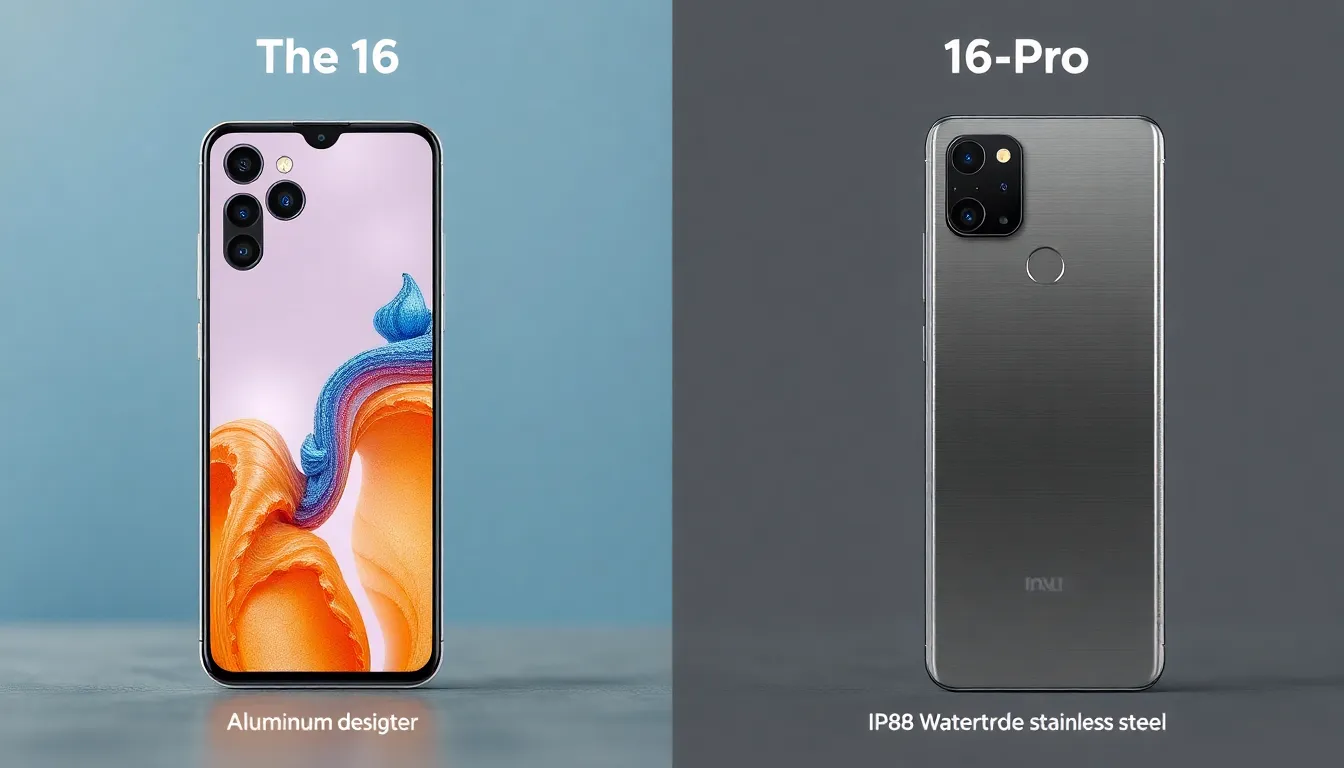In the ever-evolving world of smartphones, understanding the differences between models can be a game changer for consumers. The debate between the standard 16 and the 16 Pro has sparked interest among tech enthusiasts and everyday users alike. Each device boasts unique features and capabilities that cater to varying needs and preferences.
The 16 offers a solid performance and user-friendly experience, while the 16 Pro elevates the standard with advanced specifications and enhanced functionalities. From camera quality to processing power, knowing what sets these two models apart can help users make informed decisions. Whether you’re a casual user or a tech aficionado, exploring the distinctions between the 16 and 16 Pro is essential for finding the perfect fit.
Table of Contents
ToggleOverview of 16 and 16 Pro
The standard 16 smartphone features a balanced design, equipped with essential functionalities targeting everyday use. It boasts a reliable processor, offering smooth performance for most applications. Battery life remains solid, lasting a full day with standard usage.
The 16 Pro elevates the experience, providing advanced capabilities aimed at tech-savvy users. It includes a high-end processor, enhancing speed and efficiency in demanding tasks. With improved RAM and storage options, the Pro model delivers seamless multitasking and swift app launches.
Camera systems differ markedly between the two models. The 16 features a single camera setup, suitable for casual photography. In comparison, the 16 Pro showcases multiple lenses, enabling professional-quality images and versatile shooting options, including night mode and advanced zoom functions.
Display quality also sets them apart. The 16 offers a vibrant screen with decent resolution, catering to general viewing needs. The 16 Pro enhances this with a higher resolution display and improved brightness, suitable for media consumption and gaming.
Connectivity options remain comparable, although the 16 Pro includes additional features like enhanced wireless capabilities and support for the latest standards. This improvement ensures faster data transfer and better overall performance in various environments.
Overall, the choice between the 16 and 16 Pro rests on user preferences and specific needs. Casual users may find the standard 16 sufficient, while tech enthusiasts benefit from the enhanced features of the 16 Pro.
Design Comparison

The design of the 16 and 16 Pro models showcases distinct stylistic choices and materials that cater to different user preferences.
Dimensions and Weight
The standard 16 measures 5.78 x 2.81 x 0.29 inches and weighs 6.1 ounces. In contrast, the 16 Pro is slightly larger at 6.06 x 3.07 x 0.31 inches, weighing 7.27 ounces. This difference in size and weight contributes to the Pro’s more substantial feel, making it suitable for users who prefer a larger screen and enhanced grip during use.
Build Quality
The build quality of the 16 features an aluminum frame with a glass back, emphasizing durability while remaining lightweight. The 16 Pro, however, uses surgical-grade stainless steel, providing additional sturdiness and a premium aesthetic. Both models showcase an IP68 rating, ensuring water and dust resistance, yet the 16 Pro offers a polished finish that stands out in terms of luxury and resilience.
Performance Analysis
Performance is a crucial aspect when comparing the 16 and 16 Pro models. Both devices deliver solid capabilities, but they cater to different user needs.
Processor Specifications
The 16 features a reliable processor designed for everyday tasks and moderate multitasking. In contrast, the 16 Pro is equipped with a high-end processor that handles demanding applications and heavy multitasking with ease. The 16 Pro’s superior processing power results in faster app launches, smoother gaming experiences, and enhanced overall system responsiveness. For users needing top-tier performance, the 16 Pro excels in demanding scenarios, including video editing and complex gaming.
RAM and Storage Options
The 16 comes with adequate RAM to support standard usage patterns, allowing for smooth operation of commonly used applications. However, the 16 Pro offers an increased RAM configuration, which significantly enhances multitasking capabilities. Users benefit from seamless transitions between multiple apps and improved performance in resource-intensive tasks. In terms of storage, the 16 offers sufficient options for casual users, while the 16 Pro provides expanded storage choices to accommodate larger files, applications, and multimedia content. This additional storage flexibility meets the needs of users who require extensive media libraries and app collections.
Display Features
The display features of the 16 and 16 Pro models significantly impact user experience. Each model delivers distinct advantages aimed at different consumer needs.
Screen Size and Resolution
The standard 16 features a 6.1-inch display with a resolution of 2532 x 1170 pixels, offering a sharp and vibrant visual experience. The 16 Pro, on the other hand, boasts a larger 6.7-inch display with a resolution of 2778 x 1284 pixels, providing enhanced clarity and detail. Users engaged in gaming or media consumption benefit from the higher pixel density of the 16 Pro, resulting in more immersive visuals.
Color Accuracy and Brightness
The 16 delivers excellent color accuracy with impressive brightness levels, reaching up to 800 nits in typical usage and 1200 nits for HDR content. The 16 Pro excels further in this area, achieving a peak brightness of 2000 nits, which ensures optimal visibility even in bright conditions. Both models support wide color (P3) and True Tone technology, but the 16 Pro’s enhanced capabilities allow for more precise color reproduction, catering to photography enthusiasts and professionals requiring accurate color representation.
Camera Capabilities
The camera capabilities of the 16 and 16 Pro models significantly distinguish their photography performance. The standard 16 offers a competent camera for casual photography, while the 16 Pro provides advanced features for professional-quality imaging.
Main Camera Features
- Single vs. Multiple Lenses: The 16 includes a single 12 MP wide camera, suitable for everyday snapshots. The 16 Pro features a triple-camera system consisting of a 48 MP wide lens, a 12 MP ultra-wide lens, and a 12 MP telephoto lens, enabling versatility for various shooting scenarios.
- Image Quality Enhancements: The 16 provides solid image quality under good lighting conditions. The 16 Pro delivers superior image quality with advanced computational photography features, such as Night mode, Smart HDR 4, and Photonic Engine, enhancing details and colors in diverse conditions.
- Optical Zoom: The 16 Pro’s telephoto lens allows for 3x optical zoom, capturing distant subjects with clarity. In contrast, the 16 lacks optical zoom capability.
Video Recording Quality
- Resolution Options: The 16 supports 4K video recording at 24, 30, or 60 fps, providing clear video quality. The 16 Pro elevates video performance, featuring 4K recording at 24, 30, 60, and enhanced capabilities like ProRes video recording.
- Stabilization Technology: The 16 incorporates standard digital stabilization for smooth video capture. The 16 Pro employs advanced Cinematic mode with enhanced stabilization and Dolby Vision HDR capabilities for high-quality cinematic content.
- Frame Rates: The 16 allows for slow-motion video at 1080p resolution. The 16 Pro offers slow-motion capabilities at both 1080p and 240 fps, ideal for capturing fast-moving subjects.
Battery Life and Charging
Battery life and charging capabilities differ between the 16 and the 16 Pro, influencing user experience significantly.
Battery Capacity
The standard 16 features a battery capacity of 3,279 mAh, providing dependable all-day use for typical tasks. The 16 Pro has a larger battery at 4,422 mAh, designed for more demanding usage patterns. This additional capacity supports advanced features and heavier multitasking, maintaining efficiency throughout the day.
Charging Speed
Both models support fast charging, but charging speeds vary. The 16 supports up to 20W wired charging, reaching approximately 50% charge in about 30 minutes. The 16 Pro, however, offers faster 27W wired charging, achieving a 50% charge in around 25 minutes. Both models support MagSafe and Qi wireless charging, with the 16 providing 15W and the 16 Pro offering a slightly improved charging capability for convenience.
Pricing and Value
Pricing plays a crucial role in distinguishing between the 16 and 16 Pro models. Understanding cost differences and value propositions helps consumers make informed choices.
Cost Differences
The standard 16 model starts at $799, providing solid features suitable for casual users. In contrast, the 16 Pro begins at $1,099, reflecting its advanced capabilities and premium design. Variations in pricing occur with different storage configurations. For example, the 16 Pro offers storage options of 256 GB and 512 GB, costing $1,199 and $1,399, respectively. The 16 model’s storage options include 128 GB and 256 GB, priced at $799 and $899, respectively. Both models may incur additional costs for accessories and extended warranties.
Which One Offers Better Value?
Value assessment varies based on user needs. The 16 model offers excellent functionality for casual tasks such as social media and web browsing at a competitive price point. The 16 Pro, with its enhanced performance, advanced camera system, and superior display, caters to tech enthusiasts and professionals needing high-quality photography and intensive multitasking capabilities. The investment in the 16 Pro aligns with users seeking the latest technology, higher performance, and premium features.
Choosing between the 16 and the 16 Pro ultimately hinges on individual needs and preferences. The standard 16 offers a solid balance of performance and user-friendliness, making it a great option for casual users. Its reliable features and decent camera capabilities cater well to everyday tasks.
On the other hand, the 16 Pro stands out with its advanced specifications and superior functionalities. For those who prioritize high-quality photography, seamless multitasking, and immersive media experiences, the 16 Pro justifies its higher price point. Understanding these differences empowers consumers to select the model that best aligns with their lifestyle and usage demands.



